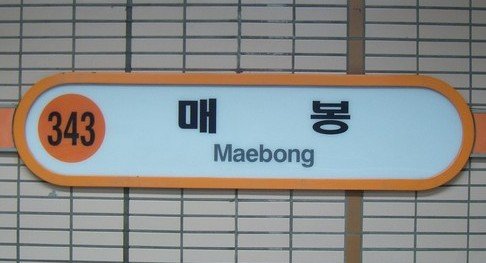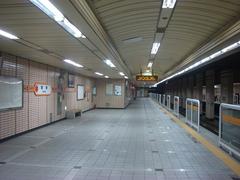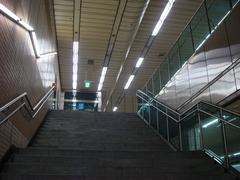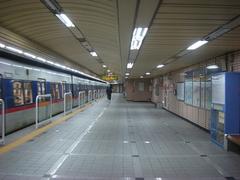
Maebong Station Visiting Hours, Tickets, and Travel Guide for Seoul Historical Sites
Date: 15/06/2025
Introduction to Maebong Station and Its Significance
Maebong Station, located in Dogok-dong, Gangnam-gu, Seoul, stands as a vital transit hub that exemplifies the city’s successful integration of modern infrastructure with its historical and cultural evolution. Established during Seoul’s rapid urban expansion in the late 20th century, Maebong Station became a key component in the strategic development of southern Seoul, particularly the affluent Gangnam district. Today, it not only facilitates seamless movement across the city via Line 3 but also anchors the vibrant residential neighborhoods of Dogok-dong and Daechi-dong—areas renowned for educational excellence and quality of life (Seoul brief insight into its history and urban development; ExploreMetro Seoul).
Operating daily from approximately 5:30 AM to midnight, Maebong Station offers efficient ticketing options, including single-ride tickets and rechargeable T-money cards, alongside comprehensive accessibility features such as elevators and tactile paving. Its strategic exits lead directly to green spaces, educational institutions, and residential complexes, making it a gateway to both urban convenience and natural escapes like Maebong Mountain Park and Dogok Park (Visit Seoul: Transportation; iamaileen.com; Trip.com: Maebong Mountain Park).
Whether you are a commuter, a history enthusiast, or a traveler seeking to experience the everyday rhythms of Seoul, this guide provides a detailed overview of Maebong Station’s historical context, visitor information, travel tips, and nearby attractions.
Table of Contents
- Introduction
- Historical Development and Urban Context
- Socioeconomic Significance
- Station Architecture and Infrastructure
- Visiting Hours and Ticketing
- Accessibility and Travel Tips
- Connectivity within Seoul Metro
- Nearby Attractions and Cultural Highlights
- Urban Regeneration and Recent Trends
- Maebong Mountain Park: Hiking and Nature
- Frequently Asked Questions (FAQ)
- Key Recommendations for Travelers
- References
Historical Development and Urban Context
Maebong Station’s inception is closely tied to Seoul’s urbanization strategy in the late 20th century. As the government sought to decentralize the city’s dense population and foster economic growth in Gangnam, new residential complexes, educational institutions, and commercial centers emerged south of the Han River (Seoul brief insight into its history and urban development). The opening of Line 3 and Maebong Station enabled direct transit links between these growing neighborhoods and the city’s traditional core, supporting both daily commutes and the area’s transformation into a desirable residential zone (Touristlink: Maebong Station).
Socioeconomic Significance
Gangnam-gu has become a symbol of prosperity, modern urban living, and educational achievement. Maebong Station is integral to this reputation, serving as a daily artery for local families, students, and professionals. The surrounding neighborhoods are known for their high concentration of “hagwons” (private academies), reputable schools, and extensive green spaces, reinforcing the district’s appeal to families and contributing to its community-oriented character.
Station Architecture and Infrastructure
Maebong Station is designed for efficiency and accessibility. It features two underground levels:
- Concourse Level (Level 1): Houses customer service, retail outlets, and ticketing facilities.
- Platform Level (Level 2): Two side platforms serve northbound and southbound trains on Line 3.
Main Exits and Surroundings
- Exit 1: Dogok Park, Gaepo Hanshin Apartment, Gaepo Useong Apartment Complex 4
- Exit 2: Maebong Tunnel, SK Leaders View Apartments, Bonjuk Maebong Branch, Kimbap Cheonguk Maebong-yeok Branch
- Exit 3: EBS (Educational Broadcasting System), Hanshin Apartments, Daechi Middle School, Dogok-dong Community Center
- Exit 4: Daechi Middle School, Gaepo Lucky Apartments, Dokgol Vicinity Park, Pizza School
Signage is multilingual, and facilities such as elevators, escalators, tactile paving, and wide fare gates ensure accessibility for all (Touristlink: Maebong Station).
Visiting Hours and Ticketing
Maebong Station operates daily from about 5:30 AM to midnight, matching Seoul Metro’s standard hours (Visit Seoul: Transportation).
Ticket Options
- Single-Journey Tickets: Purchase at station kiosks or ticket counters. Fares start at 1,250 KRW and vary by distance.
- T-money Cards: Rechargeable smart cards usable on subways, buses, taxis, and in convenience stores. Offers fare discounts and streamlined transfers.
Ticket vending machines and gates support multiple languages, ensuring ease of use for international travelers (iamaileen.com).
Accessibility and Travel Tips
- Facilities: Elevators, escalators, tactile paving, accessible restrooms, wide fare gates for wheelchairs and strollers.
- Signage: Bilingual and trilingual (Korean, English, Chinese/Japanese).
- Safety: CCTV monitoring, emergency intercoms, platform safety doors.
- Travel Tips:
- Avoid peak hours (7:30–9:30 AM, 5:30–7:30 PM) for comfort.
- Navigational apps (Naver Map, KakaoMap) are more accurate than Google Maps in Korea.
- Keep noise to a minimum in residential areas and respect local etiquette.
- Use T-money for convenience and savings.
Connectivity within the Seoul Metro
Maebong Station is not an interchange but is well-connected via Line 3 to major transit lines and city landmarks:
- Gyeongbokgung Palace
- Insadong
- Apgujeong and Sinsa (shopping and dining districts)
- Easy transfers to Lines 2, 4, 5, and others
The station also links to local bus routes for deeper exploration of Gangnam and adjacent neighborhoods.
Nearby Attractions and Cultural Highlights
Green Spaces
- Dogok Park: Serene space for relaxation and community activities.
- Maebong Mountain Park: Popular hiking spot with panoramic city views (Trip.com: Maebong Mountain Park).
- Yangjaecheon Stream: Scenic walking and cycling paths.
Educational and Community Sites
- Daechi Middle School
- Educational Broadcasting System (EBS)
- Dogok-dong Community Center
Local Dining and Markets
- Bonjuk Maebong Branch: Korean porridge restaurant.
- Kimbap Cheonguk and Pizza School: Affordable eateries.
- Neighborhood markets: Fresh produce and local snacks.
Urban Regeneration and Recent Trends
Under initiatives by city leadership, Seoul has invested in modernizing subway infrastructure, public spaces, and green corridors (Seoul brief insight into its history and urban development). Maebong Station’s ongoing upgrades and the creation of nearby parks reflect the city’s drive to balance urban growth with quality of life.
Maebong Mountain Park: Hiking and Nature
Maebong Mountain Park and the greater Cheonggyesan Mountain range offer year-round hiking, with trails accessible from dawn to dusk and no entrance fee. The main trail from Wonteogol Entrance to Maebong Peak spans about 3 km (1.5–2 hours), suitable for all skill levels. The park is famous for spring cherry blossoms, autumn foliage, and panoramic views of Seoul. After hiking, visitors can enjoy local restaurants specializing in tofu and traditional dishes (Trip.com: Maebong Mountain Park).
Getting There:
- From Maebong Station, use local buses or taxis to reach the main trailhead. Some routes require a transfer via Yangjae Station; check mobile navigation apps for the best route based on your needs.
- Facilities are well maintained, but check elevator and accessibility availability before your visit if needed.
Frequently Asked Questions (FAQ)
Q: What are Maebong Station’s operating hours?
A: Approximately 5:30 AM to midnight daily.
Q: How do I buy tickets?
A: Use multilingual vending machines or ticket counters; T-money cards are recommended for convenience.
Q: Is the station accessible for people with disabilities?
A: Yes—elevators, escalators, tactile paving, and wide fare gates are available.
Q: What are the best nearby attractions?
A: Maebong Mountain Park, Dogok Park, Yangjaecheon Stream, and local community centers.
Q: Are there guided tours?
A: There are no official tours at Maebong Station, but the area is easily explored independently.
Key Recommendations for Travelers
- Best Times to Visit: Spring and autumn for pleasant weather and beautiful scenery.
- Transit Tips: Use T-money cards, avoid peak commute times, and download local navigation apps.
- Accessibility: Plan ahead for elevator locations if you have mobility needs.
- Cultural Etiquette: Maintain a respectful demeanor, especially in residential zones.
- Connectivity: Free Wi-Fi is available in the station; SIM cards and portable Wi-Fi can be purchased at airports.
References
- Seoul brief insight into its history and urban development
- Maebong Station in Seoul: Visiting Hours, Tickets, and Nearby Attractions
- Visiting Maebong Station: Hours, Tickets, and Exploring Seoul’s Residential Heart
- Maebong Station Guide: Hours, Tickets, Accessibility & Nearby Attractions in Seoul
- Visiting Maebong Mountain Park: Hiking Tips, Access via Maebong Station, and Nearby Attractions
- Visit Seoul: Transportation
- NextStopKorea: June in South Korea
- Travel Stained: Korea in June - Weather & Things to Do















































































































































































































